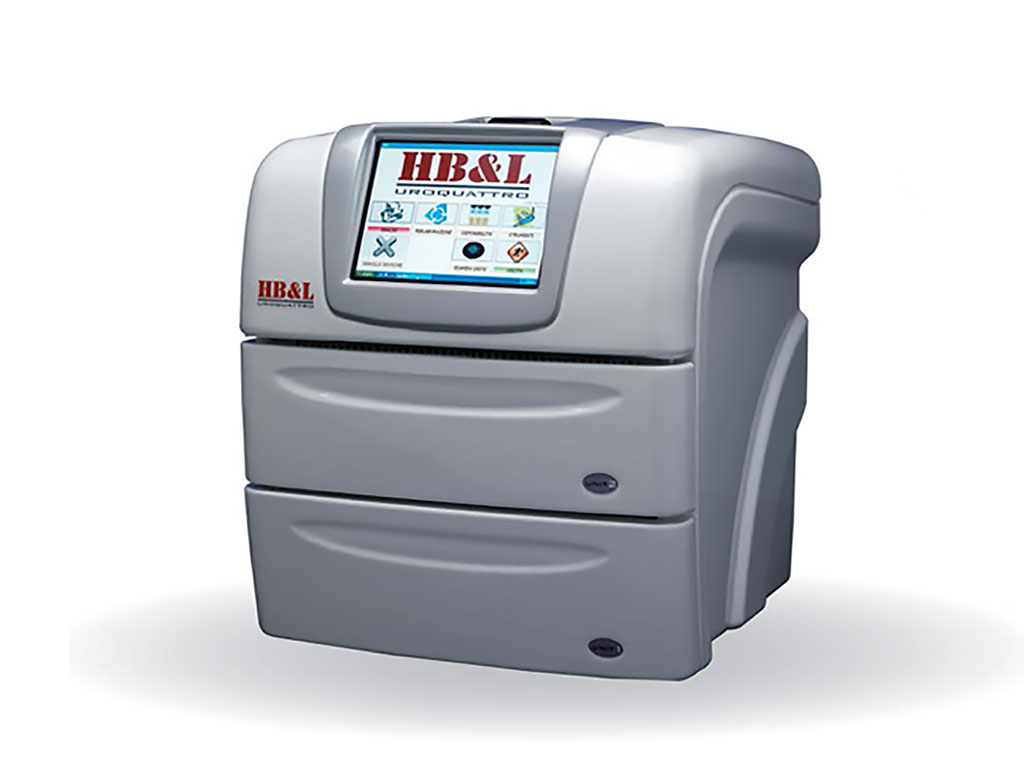Alifax S.r.l. Highlights First Automated System for Bacterial Culture and Susceptibility Testing
|
By LabMedica International staff writers Posted on 20 Nov 2019 |

Image: Alifax HB&L (Photo courtesy of Alifax S.r.l.)
Alifax S.r.l. (Padua, Italy) highlighted its innovative diagnostic instrumentation portfolio at the 2019 edition of MEDICA, the world's largest trade fair for medical technology, held from 18 to 21 November in Düsseldorf, Germany.
Alifax is present in the laboratory diagnostic market and develops instruments and kits with a focus of the total laboratory automation requirements providing fast and reliable results, method standardization, sample traceability and easy-to-use protocols. Alifax’s innovative diagnostic products include Test1 and Roller 20 for the analysis of ESR in 20 seconds, Alfred AST sepsis analyzer for RAPID Bacterial Culture, antimicrobial susceptibility testing and MDRO screening and ALIBOX, a smart patented device designed to improve and certify bio-material transportation by active temperature control and multiple-parameter monitoring as temperature and location on a cloud-based service. It has also introduced the new I-dOne, a reagent free ATR-FTIR based system for microorganism identification in only one minute from isolated colony without sample preparation or pre-treatment.
At MEDICA 2019, Alifax highlighted its real walk-away automated streaking system for rapid bacterial culture and plate streaking of liquid samples that is composed of two units: Alfred 60AST and Sidecar. Alfred 60AST is the first fully automated system able to perform bacterial culture, RAA and susceptibility testing by automating the entire process of sample inoculation, reading and result transmission. Using patented technology based on light scattering, it is able to detect the presence of bacteria and their drug resistance in a few hours with high sensitivity and specificity. Alfred 60AST monitors the growth phases of bacteria from the inoculum step into specific culture broths, providing real time growth curves and quantitative bacterial count results in CFU/ml. Broth turbidity level is detected by the McFarland Monitor and as the sample reaches the 0.5 McFarland, it is buffered into the refrigerated area and then tested with a customized antibiotic panel. The Sidecar streaking unit stocks 240 Petri dishes and up to 12 different media. The streaked dishes are incubated on board at 37°C for the requested analysis time.
Alifax also highlighted HB&L, the first analyzer able to perform bacterial culture, RAA test and susceptibility testing on samples such as urine, sterile or non sterile fluids and other biological samples. Using patented technology based on light scattering, it can detect the presence of bacteria and their drug resistance in a few hours with high sensitivity and specificity. HB&L also monitors the growth phases of bacteria from the inoculum step into specific culture broths providing real time growth curves and quantitative bacterial count results in CFU/ml. Broth turbidity level is detected by McFarland Monitor and, as the sample reaches the 0.5 McFarland, a visual and audible alert advises that the bacterial culture is ready to be tested for a customized antibiotic panel without awaiting the end of the analysis and avoiding further dilution steps. HB&L’s software flexibility allows different tests to be performed simultaneously, with each reading unit position being independent from the others and can be set according to sample type, incubation time, test profile, analytical protocol and cut-off.
Related Links:
Alifax S.r.l.
Alifax is present in the laboratory diagnostic market and develops instruments and kits with a focus of the total laboratory automation requirements providing fast and reliable results, method standardization, sample traceability and easy-to-use protocols. Alifax’s innovative diagnostic products include Test1 and Roller 20 for the analysis of ESR in 20 seconds, Alfred AST sepsis analyzer for RAPID Bacterial Culture, antimicrobial susceptibility testing and MDRO screening and ALIBOX, a smart patented device designed to improve and certify bio-material transportation by active temperature control and multiple-parameter monitoring as temperature and location on a cloud-based service. It has also introduced the new I-dOne, a reagent free ATR-FTIR based system for microorganism identification in only one minute from isolated colony without sample preparation or pre-treatment.
At MEDICA 2019, Alifax highlighted its real walk-away automated streaking system for rapid bacterial culture and plate streaking of liquid samples that is composed of two units: Alfred 60AST and Sidecar. Alfred 60AST is the first fully automated system able to perform bacterial culture, RAA and susceptibility testing by automating the entire process of sample inoculation, reading and result transmission. Using patented technology based on light scattering, it is able to detect the presence of bacteria and their drug resistance in a few hours with high sensitivity and specificity. Alfred 60AST monitors the growth phases of bacteria from the inoculum step into specific culture broths, providing real time growth curves and quantitative bacterial count results in CFU/ml. Broth turbidity level is detected by the McFarland Monitor and as the sample reaches the 0.5 McFarland, it is buffered into the refrigerated area and then tested with a customized antibiotic panel. The Sidecar streaking unit stocks 240 Petri dishes and up to 12 different media. The streaked dishes are incubated on board at 37°C for the requested analysis time.
Alifax also highlighted HB&L, the first analyzer able to perform bacterial culture, RAA test and susceptibility testing on samples such as urine, sterile or non sterile fluids and other biological samples. Using patented technology based on light scattering, it can detect the presence of bacteria and their drug resistance in a few hours with high sensitivity and specificity. HB&L also monitors the growth phases of bacteria from the inoculum step into specific culture broths providing real time growth curves and quantitative bacterial count results in CFU/ml. Broth turbidity level is detected by McFarland Monitor and, as the sample reaches the 0.5 McFarland, a visual and audible alert advises that the bacterial culture is ready to be tested for a customized antibiotic panel without awaiting the end of the analysis and avoiding further dilution steps. HB&L’s software flexibility allows different tests to be performed simultaneously, with each reading unit position being independent from the others and can be set according to sample type, incubation time, test profile, analytical protocol and cut-off.
Related Links:
Alifax S.r.l.
Latest Medica 2019 News
- Mast Group Introduces New MAST CARBA PAcE for Rapid Carbapenemase Detection
- DRG Instruments Demonstrates DRG:HYBRID-XL Fully Automated Lab Analyzer
- Diatron Introduces New Aquila 5Dretic 5-Part Differential Hematology Analyzer
- Erba Mannheim Showcases New Launches at MEDICA 2019
- EUROIMMUN Showcases Immunoassay Testing Products at MEDICA 2019
- Diconex S.A. Exhibits InCCA Intelligent Clinical Chemistry Analyzer at MEDICA 2019
- Chembio Diagnostics Showcases New DPP Line of Rapid Tests at MEDICA 2019
- DYNEX Demonstrates DYNABLOT Automatic Analyzer for Immunoblot and Westernblot Methods
- Systec Launches New and Improved HX-150 Autoclave at MEDICA 2019
- TaiDoc Showcases Multi-Parameter Monitoring Systems and Advanced Devices
- IDS Exhibits Next Generation Automated Immunoanalyzer IDS-i10 at MEDICA 2019
- JEOL Ltd. Introduces BioMajesty Series of Clinical Chemistry Analyzers at MEDICA 2019
- EKF Diagnostics Showcases Full Product Range at MEDICA 2019
Channels
Clinical Chemistry
view channel
‘Brilliantly Luminous’ Nanoscale Chemical Tool to Improve Disease Detection
Thousands of commercially available glowing molecules known as fluorophores are commonly used in medical imaging, disease detection, biomarker tagging, and chemical analysis. They are also integral in... Read more
Low-Cost Portable Screening Test to Transform Kidney Disease Detection
Millions of individuals suffer from kidney disease, which often remains undiagnosed until it has reached a critical stage. This silent epidemic not only diminishes the quality of life for those affected... Read more
New Method Uses Pulsed Infrared Light to Find Cancer's 'Fingerprints' In Blood Plasma
Cancer diagnoses have traditionally relied on invasive or time-consuming procedures like tissue biopsies. Now, new research published in ACS Central Science introduces a method that utilizes pulsed infrared... Read moreMolecular Diagnostics
view channel
Revolutionary Blood Test Detects 30 Different Types of Cancers with 98% Accuracy
With cancer expected to become the leading cause of global mortality by 2030, early detection remains the most effective strategy to reduce death rates. Current screening methods only cover five types... Read more
Simple Blood Test Better Predicts Heart Disease Risk
Cardiovascular diseases (CVDs) are the primary cause of death worldwide. A large proportion of these cases could be prevented by addressing lifestyle and environmental factors such as smoking, poor diet,... Read moreHematology
view channel
New Scoring System Predicts Risk of Developing Cancer from Common Blood Disorder
Clonal cytopenia of undetermined significance (CCUS) is a blood disorder commonly found in older adults, characterized by mutations in blood cells and a low blood count, but without any obvious cause or... Read more
Non-Invasive Prenatal Test for Fetal RhD Status Demonstrates 100% Accuracy
In the United States, approximately 15% of pregnant individuals are RhD-negative. However, in about 40% of these cases, the fetus is also RhD-negative, making the administration of RhoGAM unnecessary.... Read moreImmunology
view channel
Stem Cell Test Predicts Treatment Outcome for Patients with Platinum-Resistant Ovarian Cancer
Epithelial ovarian cancer frequently responds to chemotherapy initially, but eventually, the tumor develops resistance to the therapy, leading to regrowth. This resistance is partially due to the activation... Read more
Machine Learning-Enabled Blood Test Predicts Immunotherapy Response in Lymphoma Patients
Chimeric antigen receptor (CAR) T-cell therapy has emerged as one of the most promising recent developments in the treatment of blood cancers. However, over half of non-Hodgkin lymphoma (NHL) patients... Read moreMicrobiology
view channel
Handheld Device Delivers Low-Cost TB Results in Less Than One Hour
Tuberculosis (TB) remains the deadliest infectious disease globally, affecting an estimated 10 million people annually. In 2021, about 4.2 million TB cases went undiagnosed or unreported, mainly due to... Read more
New AI-Based Method Improves Diagnosis of Drug-Resistant Infections
Drug-resistant infections, particularly those caused by deadly bacteria like tuberculosis and staphylococcus, are rapidly emerging as a global health emergency. These infections are more difficult to treat,... Read more
Breakthrough Diagnostic Technology Identifies Bacterial Infections with Almost 100% Accuracy within Three Hours
Rapid and precise identification of pathogenic microbes in patient samples is essential for the effective treatment of acute infectious diseases, such as sepsis. The fluorescence in situ hybridization... Read morePathology
view channel
Sensitive and Specific DUB Enzyme Assay Kits Require Minimal Setup Without Substrate Preparation
Ubiquitination and deubiquitination are two important physiological processes in the ubiquitin-proteasome system, responsible for protein degradation in cells. Deubiquitinating (DUB) enzymes contain around... Read more
World’s First AI Model for Thyroid Cancer Diagnosis Achieves Over 90% Accuracy
Thyroid cancer is one of the most common cancers worldwide, and its precise management typically relies on two primary systems: (1) the 8th edition of the American Joint Committee on Cancer (AJCC) or ... Read more
Breakthrough Diagnostic Approach to Significantly Improve TB Detection
Tuberculosis (TB) remains the deadliest infectious disease globally, with 10.8 million new cases and 1.25 million deaths reported in 2023. Early detection through effective screening is crucial in identifying... Read more
Rapid, Ultra-Sensitive, PCR-Free Detection Method Makes Genetic Analysis More Accessible
Genetic testing has been an important method for detecting infectious diseases, diagnosing early-stage cancer, ensuring food safety, and analyzing environmental DNA. For a long time, polymerase chain reaction... Read moreTechnology
view channel
Disposable Microchip Technology Could Selectively Detect HIV in Whole Blood Samples
As of the end of 2023, approximately 40 million people globally were living with HIV, and around 630,000 individuals died from AIDS-related illnesses that same year. Despite a substantial decline in deaths... Read more
Pain-On-A-Chip Microfluidic Device Determines Types of Chronic Pain from Blood Samples
Chronic pain is a widespread condition that remains difficult to manage, and existing clinical methods for its treatment rely largely on self-reporting, which can be subjective and especially problematic... Read more
Innovative, Label-Free Ratiometric Fluorosensor Enables More Sensitive Viral RNA Detection
Viruses present a major global health risk, as demonstrated by recent pandemics, making early detection and identification essential for preventing new outbreaks. While traditional detection methods are... Read moreIndustry
view channel
Cepheid and Oxford Nanopore Technologies Partner on Advancing Automated Sequencing-Based Solutions
Cepheid (Sunnyvale, CA, USA), a leading molecular diagnostics company, and Oxford Nanopore Technologies (Oxford, UK), the company behind a new generation of sequencing-based molecular analysis technologies,... Read more
Grifols and Tecan’s IBL Collaborate on Advanced Biomarker Panels
Grifols (Barcelona, Spain), one of the world’s leading producers of plasma-derived medicines and innovative diagnostic solutions, is expanding its offer in clinical diagnostics through a strategic partnership... Read more










 Assay.jpg)











